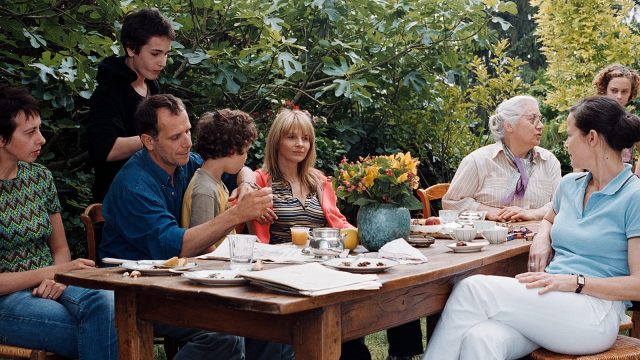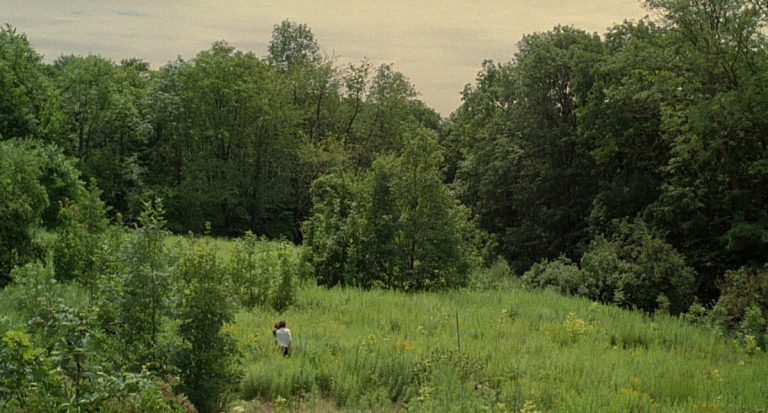Wouldn’t you know A.O. Scott has already written the perfect reflection on this movie? Here’s the deal: before jotting down my own thoughts, I like to browse other reviews and essays to get a sense of reception, observations and context I may not be aware of, etc. But Scott’s review is such an infuriatingly precise expression of what I initially wanted to say that I have to switch gears a bit and talk about what draws me to Assayas overall, and how I believe Summer Hours fits into his eclectic but consistently great body of work. What qualities does this intimate family drama share with such a widely disparate range as his meditations on cinema (Irma Vep), his art-porn thriller (Demonlover), his terrorist biopic (Carlos), his actress-rivalry soap (Clouds of Sils Maria) and his quasi-horror whatsit (Personal Shopper)? What do we mean when we call something an Assayas film, and how does Summer Hours fit into that vision?
Let’s start with the matter of this movie itself: three adult siblings are reuniting to celebrate their mother’s 75th birthday. Their widowed mother (Édith Scob) is concerned about what will happen to her and her late husband’s material possessions after she passes. Over the course of the film, we learn more about their divergent lives, how one of their children (Charles Berling) still lives in France with his own wife and kids, one (Juliette Binoche) has moved to New York and lands an American fiancé, and one (Jérémie Renier) has moved his family to Beijing to pursue his corporate ladder-climbing. The film covers their birthday reunion and leaps ahead in time after.
These complexities play out in ways both expected and unexpected. Like in any serious adult drama, the reunion of the siblings leads both to the joy of reunion itself and to old arguments, old wounds, resurfacing passively and actively. Disagreement arises between and among the generations about what their responsibilities to themselves and to one other may be. Their visions of happiness differ. Their visions of the future differ. Most movies in this genre stop here, but Assayas keeps piling on the angles like a thematic Escher print. The family is divided not only by life philosophy but by economics. By material relationships. By national attitudes. By language, even. Whole sections of the film may function as an allegory for the French cinema industry (not least: the torch passing from the classic movie star Scob to the currently reigning titans to the young people who play their children). The young people are meanwhile forging their own meanings separate from their parents. Ultimately, the most engaging character in the film may not be a person at all, but a writing desk.
In the Criterion supplement, Assayas says he was after an expression of
the complexity of the experience of being a human being in your time. It involves a lot of angles. It involves a lot of complementary approaches. I have this feeling that, movie after movie, I’m trying to build something that deals with the contradictions, the conflicts, and the complexities of our experience of the world.
What keeps these disparate elements together from film to film is not any of the usual (visual) signifiers of auteurism: Assayas is a very good director in the technical sense (see below) but not usually a showy or stylistically idiosyncratic one; that is, not a director whose visual stamp is immediately recognizable and irreducible to him as such. Rather, if there is an authorial stamp, an Assayas film is characterized by the way he embraces a wide variety of thematic materials, sometimes even wildly unrelated materials, interwoven to create an experience of a whole. In other words, some filmmakers are thematically singular, some are a bit more complex and multifaceted, but, at their best, Assayas’ films approach as close to a kind of thematic polyphony as anyone working today. It is often difficult to state clearly what an Assayas film is actually “about,” because it is typically “about” the experience of its many parts.
Take Irma Vep, my very favorite of his movies. The operative nucleus is the French film industry’s reckoning with its future, whether that will mean more emphasis on art or popular film. Assayas explores this question literally in the plot, as the characters debate the nature of the project they are creating, but also the many intertwined tendrils that branch from the central nucleus: the nature of film financing and globalization (both in production and in distribution), the question of whether (and which) artistic values can transcend cultural borders and whether some forms of artistic expression “belong” to a particular culture, whether remaking an existing property can or should be a sufficient vessel for one’s own personal expression, the figure of the Movie Star as an artificial and syncretic concoction that merges the authentic (or an authentic sensibility) with the inauthentic, the figure of the director as auteur or as stage manager for a communal production, the question of art as commerce, of art as expression, of art as legacy, of art as failure. And further still: what it means to be inside or outside of a culture, of a language, of a community, and what it means to be a visitor passing through. What it means to be a classic, or a revolutionary, to be aging out of a zeitgeist or on the cusp of a new one. Any one of these threads would make for an interesting discussion in itself, but Assayas refuses to limit focus on any one, since doing so would unravel that wholeness he believes allows film to approach the wholeness of life. We could build similar lists of themes for Carlos, or Clouds of Sils Maria, or Personal Shopper, or even the one Assayas film I didn’t much care for, Demonlover.
Despite these films being “experiential,” Assayas is not usually an affective director, like other great directors of pure experience (Lynch, Weerasethakul, his fellow countryman Carax): rather, he is an analytic director who begins with a small cluster of material and expands outwards. We might contrast this to the approach of other analytically minded directors, where a single issue (or cluster of issues) is subjected to intense scrutiny from a number of angles, that is, from the outside looking in, exploring various facets of that particular nucleus. We might say the gravitational center of Moonlight is black masculinity, or the gravitational center of Phantom Thread is the dynamics of power, or the gravitational center of 45 Years is the problem of transparency in relationships. None of these films (all of which are great films) are narrowly conceived, but their various pieces of thematic material are ways of reflecting back on different facets of those nuclei, finding productive angles of approach from all sides, like a classical theme with variations. They are just as analytically sophisticated, but come from the opposite direction.
Summer Hours is a typical Assayas film in how it explodes outwards instead, this time with a more unusual nucleus: a set of objects from the Musée d’Orsay. The museum had planned to commission four films to celebrate its 20th anniversary, with only two of those films (this and Hou Hsiao-Hsien’s The Red Balloon) completed before the project was terminated (the other two films would have come from Raoul Ruiz and Jim Jarmusch!) Assayas took the commission literally by examining the objects in the museum as objects in a museum: what are they? what do they mean by being there? who are we by looking at them?
Objectness is already a vital part of cinema given how the camera-subject takes in material for our consumption, but outside of critical works on things like gaze, it’s usually an implied relationship rather than an explicit one. Assayas opens up a broader dialogue by having the characters express their own subject-ive relationship to their possessions and soon-to-be museum pieces. This makes it sound way more intellectual than its actual presentation in the film, which expresses these concerns in dramatic form: some characters want their possessions to stay in the family, others want to shed them as an expression of growth, some have concrete and vivid emotional relationships to the pieces, others treat them as anonymous things, etc., etc. In the end, however, everyone is on the other side of the red rope.
In the Criterion interview with Serge Lemoine, then-President of the Musée D’Orsay, he notes that Assayas was interested not so much in “the museum as such, but the theme of patrimony, the theme of memory, the theme of transmission, the theme of people’s relationships with objects, and so on.” That “and so on” is precisely what I’m arguing is the key to Assayas’ approach, the inability of his films to be reduced back to the thematic cluster from which they emerged: the final work is too expansive, too generous in its attempt to explore everything, to follow productive tangents sometimes three or four steps removed from their initial source. Assayas himself says that his own mother’s impending death humanized his approach to the material, bringing a human depth to “whatever the film was about”: note, even here, the desire not to pin down a central theme.
One of the reasons the critical reception to Summer Hours was so strong is that it’s also one of his most visually assured films, which may be a quality of its reduced scope, though it never feels reduced. In other words, Assayas often challenges himself with difficult or stylish setpieces — the avant garde finale of Irma Vep, the hostage standoff in Carlos, the ghostly apparitions of Personal Shopper — where here he has a lovely house and muted tone. But that seeming simplicity belies just how confident his work can be. Note the following two-part scene. The first is a mini-masterpiece of choreography, allowing the focal center to shift among groups of people as the camera slowly pans toward the open trunk of the car. He then switches angles (a 180-degree flip, no less) as characters depart, ending the scene with Scob alone in what was previously cluttered space. This transitions to a quiet, almost perfectly still scene of her conversation with the housekeeper, showing off both the expansive and the interior aspects of his filmmaking at their very best:
There are so many more things I could say about the film — especially its final shot, which expresses that gossamer mix of nostalgia and youth and sunshine and possibility that Linklater consistently strives for (and inconsistently succeeds at) — but with such an expansive work, the more important thing is to watch it yourself and experience all its wholeness and everythingness in your own way. Assayas seems to be saying, with all due respect to the Musée d’Orsay, that life is what takes place outside the museum.




